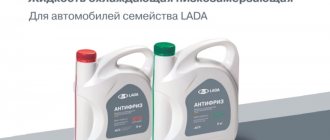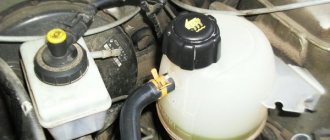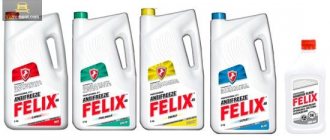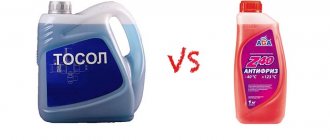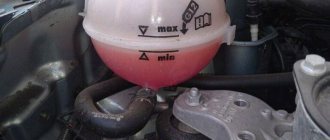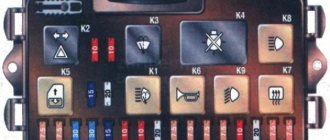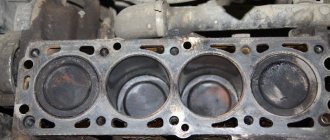Antifreeze
The cooling system is filled year-round with a mixture of water and antifreeze with an anti-corrosion additive from the VW/SEAT concern.
This mixture prevents freezing and corrosion of the cooling system, salt deposits and, in addition, increases the boiling point of the coolant. In the circulation circuit, as a result of the expansion of the liquid when heated, increased pressure is created, which also contributes to an increase in the boiling point of the coolant. The pressure is limited by a valve located in the expansion tank cap, which opens at a pressure of 1.4 - 1.6 bar. For the engine cooling system to function flawlessly, a high boiling point of the coolant is required. If the boiling point is too low, vapor locks can form, causing poor engine cooling. Therefore, the cooling system must be filled with a mixture of water and antifreeze all year round. It is necessary to use antifreeze G12 Plus (purple color, exact designation G 012 A8F) or another con, for example, Glysantin-Alu-Protect-Premium/G30.
If the cooling system is filled with a mixture containing G12 antifreeze (red, exact designation G 012 A8D), then red G12 antifreeze or another con, for example, Glysantin-Alu-Protect/G30, can also be used to replenish the coolant level. Note: G12 purple can be mixed with G12 red.
Caution: Do not mix red G12 antifreeze with the older green G11 antifreeze, as this can cause severe engine damage. The coolant is brown (the result of mixing antifreeze G12 and G11), replace it immediately.
Note: If a liquid with an antifreeze additive of the wrong specification accidentally ends up in the cooling system, the system must be flushed. To do this, all liquid from the cooling system should be completely drained and the system filled with clean water. Leave the engine idling for two minutes. Drain the water again and blow out the system from the side of the expansion tank with compressed air to completely empty it. Close the drain plug and fill the cooling system with a mixture of water and G12-Plus antifreeze.
Attention: To replenish the cooling system (also in the warm season), only use a mixture of G12-Plus (purple) with soft, clean water. The proportion of antifreeze, also in summer, should not be lower than 40%. Therefore, when refilling the cooling system Antifreeze should always be added to water.
In our latitudes, the coolant should provide protection against freezing down to -25 °C, or even better - down to -35 °C. The proportion of antifreeze should not exceed 60% (antifreeze protection of the coolant down to -40 °C), otherwise the antifreeze protection and cooling effect of the liquid are reduced. Note: depending on the vehicle equipment, the amount of coolant added may differ slightly from the values indicated in the table
Ratio of coolant components in liters
Coolant regulates many important processes in a car. For example, it cools the motor, it affects the temperature sensor and its indicators (during normal operation, the indicator should be at a low level). And in order to maintain all these processes normally, the VAZ 2106 antifreeze must be replaced on time.
Principle of operation
The main place in a car is not the driver’s seat or even the steering wheel, but the engine.
It is even called the heart. And this is not without reason, because the correct functioning of this heart directly determines whether the car will go or not. And in order not to destroy such an important technical unit, it is necessary to maintain a certain temperature and cool it in time. The operating principle of this system is quite simple, but at the same time technically well thought out. It is connected by pipes to the engine itself, the radiator and the interior heater. To understand the importance of these elements, you need to know their main functions:
- Maintaining the required temperature.
- Engine cooling.
- Warming up the car interior.
In the first case, for engine operation and proper combustion of the fuel mixture, a certain and stable temperature is required. If it is higher or lower, it has a very bad effect on the engine. In the second case, the engine is protected from overheating, which can lead to deformation of some parts inside.
If you exclude the last item from the list, then operating the car will become impossible in cold weather. And a key role in this system is played by a special liquid, without which the presence of a cooling cycle would be meaningless.
Types of coolants
To absorb heat and remove it from hot spots in the engine, the system requires coolant. There are several types of cooling liquids:
- Water.
- Antifreeze.
- Antifreeze.
But in the harsh realities of the Russian climate, the use of water as a coolant is impractical.
And it boils away very quickly, having a rather low thermal conductivity. You don’t even need to mention how it affects the occurrence of corrosion. Antifreeze is the most common among domestic car owners, but it has some disadvantages, for example, the formation of an oil film inside the vessels and pipes, which prevents normal heat transfer. Accordingly, heat removal becomes ineffective.
The third option has more pros than cons. Firstly, antifreeze begins to crystallize at very low temperatures, that is, it does not freeze, which is why it got its name. This advantage allows the use of antifreeze even in the Far North. Secondly, the thickness of the oil film formed inside the vessels is very small, thanks to which almost nothing interferes with the transfer of heat. This is achieved due to the fact that antifreeze, unlike antifreeze, is made from organic components.
The main disadvantage of antifreeze is its price, especially if you need to replace the entire fluid. Antifreeze wins here, and it is more rational to use it in car models such as the VAZ-2101 or VAZ-2106. In models of the domestic automobile industry with impressive age and mileage, the cooling system often becomes a sore and vulnerable spot. Therefore, the owners of these cars need to know the principle of operation of the cooler and understand how to repair it, which will help avoid spending on services and auto repairmen.
How to change coolant
Before replacing the coolant, you need to figure out how to fill it correctly, where, what quantity is needed and what brand. The draining and filling of this substance occurs in the expansion tank, which is located in the engine compartment on the left side of the mudguard on a bracket and secured with clamps.
Temperature sensor locations
You will need a volume of 10 liters of antifreeze or antifreeze. Which is better for you? According to reviews, the first one slightly exceeds the indicators; it is also sold in a ready-made form, or it needs to be diluted in a simple proportion (50 to 50). Choose a high-quality and reliable brand.
Before replacing, do not forget to check the temperature gauge (sensor). It is the first criterion that signals immediate replacement. If the temperature is above normal, then start measuring the level. For this:
- Unfasten the rubber strap.
- Unscrew the tank cap and look at the mark (it should be 3-4 mm higher than “min”).
If the level is below normal, then it’s time to start replacing.
Other spare parts for VAZ (Lada) 2101/2103/2106
Having found out which antifreeze the owners of VAZ (Lada) 2101/2103/2106 prefer to install, you can look at other popular spare parts for this car. In September 2022, the leaders on PartReview were:
You can also find out what the owners of VAZ (Lada) 2101/2103/2106 chose among manufacturers of such spare parts as: Pump, Thermostat, Suspension springs, Shock absorber struts, Brake discs, and others.
Source: https://partreview.ru/auto/vaz-60/210121032106-1117/antifriz-123/
Drain
To get started, make sure you have all the necessary tools:
- key or head;
- screwdriver;
- container for draining;
- stock of new coolant.
Removing the radiator cap
If your engine is cool, you can start working right away.
- Park the car on a level road.
- Open the hood and remove the radiator cap.
- Unscrew the cap from the tank.
- Place a container for draining (one that can hold at least 5 liters).
- Unscrew the bolt and also the radiator cap. Now you can drain everything.
Coolant functions
- Maintaining normal temperature during engine operation (injector).
- Maintaining low temperature in the gearbox (hydraulic fluid that needs to be poured into the automatic transmission).
- Interior heating in winter. Pouring antifreeze provides heat to the car by passing through the heater. The motor heats the liquid, and the fan blows air and transfers heat. Thus, heated air enters the cabin.
Antifreeze in the VAZ 2107 should be replaced every 45,000 km. or once every two years, whichever comes first. Because over time the quality deteriorates and this leads to adverse consequences.
Radiator cap open
Fill in
If the first part of the procedure was successful, then you can safely proceed to the second.
- Tighten the bolt.
- Fill the radiator with the required amount of antifreeze or antifreeze.
- Remove the hose and let the substance flow into it so that it flows out the other side. Lift the tank, insert the hose and pour in completely.
- Turn on the engine before the fan starts.
- Turn it off and check the sensor and level.
- Now tighten the radiator cap and tank cap. Screw on the cap and close the hood.
Done, the replacement in the VAZ 2106 was completed successfully.
Pour liquid into a special hole
see also
Comments 82
Guys, I urgently need advice! My radiator is leaking. I had to replace it. Now I choose antifreeze. I'm reading the thread below, I'm a little confused, which one is better to take, red or G11? What do you think?
What kind of mess is in your head, Soforum member? both red and G11, but in the end these are all absolutely the wrong criteria. You need to choose antifreeze ONLY with permission from the manufacturer. Because red is just a dye and the color does not affect the composition of the antifreeze at all, it can be absolutely anything. And the classification according to G is only relevant for VAG cars, that is, Skoda, etc. And since you are writing in this thread, then I dare to assume that you have a VAZ)). For our cars, the best solution is Coolstream brand antifreeze. European quality, have official approvals from the VAZ plant. Coolstream Standard is ideal for the 6, as well as other vases. All tolerances are present, so you can take it with confidence
Did you flush the system when switching from antifreeze to antifreeze? And how if I washed it)
Any decent G-11 antifreeze. Inexpensive and good - Felix. I filled myself with Mobil green, which is in fact BASF Glysantyne, while it still cost a reasonable amount
In 2106, only antifreeze was poured, there were no complaints, and now there are no complaints about antifreeze in Renault! Antifreeze G11 is essentially the same antifreeze, just a different color! The common ingredient they have in common is propylene glycol!) The rest is additives!
I dare to correct you, the current antifreeze is antifreeze and not vice versa.
Considering that there has been no antifreeze as such for a long time, there is no point in comparing. Tholos has disappeared since the times of the Soviet Union, now antifreeze is the name. Fill with antifreeze or antifreeze, but not with water. With water, a deposit will be deposited on the pump and in the radiator, which cannot be washed away by anything, and if it is washed off, it will clog everything to hell. And here the main thing is not what to pour, but how much to pour. All fluids in the car must be changed according to regulations and not when something breaks. In the CIS countries, it is somehow not customary to change fuel fluid and antifreeze every 2-3 years. And if you add only what was filled in. No antifreeze is friendly with another. Nothing bad will happen, of course, but a residue will remain =)))) I myself use HEPU, which is good, even German antifreeze. You shouldn’t save on this once every 2-3 years, you can spare a little money so that later there will be fewer problems with the entire cooling system
I agree with you completely!
Look in my blog for a photo of a can of green antifreeze (antifreeze). It rained in Siberia, -40 it didn’t freeze.
And mine doesn’t freeze)) I’m just interested in people’s opinions)
ordinary consumer antifreeze, like everyone else. The only difference is the price. Now, if they recommend Toyota antifreeze to you, will you pour it into your Lada? the answer is obvious. Hell, it should be changed once every two years, just like the brake fluid - once every two years. And in Russia everyone drives for decades without changing antifreeze and brake fluid. Oil once every three months, if you drive 2000 km per month. 2000 + 2000 + 2000 = 6000 thousand km. Or the oil is changed every 6 months, regardless of whether you have driven 6000 km or not. It's all written in old books...
I have read Soviet books)) it’s clear that I certainly won’t pour Toyota coolant for 700 rubles a liter)
First: do not mix different brands of coolant. Second: when buying, try it on your tongue. Non-freezing coolants (the same TOSOL) are sweet. If it’s sour or salty, it’s fake! The density is faked, but the taste is not. (Here you should spit and rinse your mouth, don’t be afraid, you won’t get poisoned). Third: water cools better than coolant; it has a higher heat capacity. Fourth: the coolant can be diluted with water even 1:10, it will not freeze, but will simply become sludge. Fifth: the cooling system must be in order and working properly. The sensor works, the electric fan turns on on time, and the coolant does not leak. They put it in order - that's right. Good luck to you.
PS. Bad advice. If the cooling system is leaking and does not hold water, pour a spoonful of mustard powder into the radiator. The leak will stop. But after a while it will flow again. Mustard is a one-time promotion to get there. If you do this constantly, you will clog the block with mustard.
If you mix it, nothing will happen, you’re right about mustard. Maybe the stove will clog
If you mix it, maybe nothing will happen. Or maybe it will eat the hoses, if you're lucky. About mustard - first the stove clogs, then the block and the radiator, it boils and steam comes out, like from a samovar.
No, wait, wait. That is, individually, neither one nor the other hose will spoil, but if mixed together, they will spoil it? Not entirely logical.
Together they can ruin the hoses because they can react chemically with each other and form substances that will damage the hoses. Everything is simple and logical.
Many automotive fluids react with each other. If you mix brake fluid DOT 4 (Neva, Rosa) and BSK, then the rubber bands of the brake system will be corroded 100%. Oil from different manufacturers, when mixed, can form a substance in the form of snot with grease. I saw the corroded, swollen tubes of the cooling system myself, but I don’t know how it happened, it was not my car.
So I'm lucky. I mixed everything and everyone, nothing corroded or reacted :-):-):-) But I pour it in, it’s by no means the most expensive.
First: do not mix different brands of coolant. Second: when buying, try it on your tongue. Non-freezing coolants (the same TOSOL) are sweet. If it’s sour or salty, it’s fake! The density is faked, but the taste is not. (Here you should spit and rinse your mouth, don’t be afraid, you won’t get poisoned). Third: water cools better than coolant; it has a higher heat capacity. Fourth: the coolant can be diluted with water even 1:10, it will not freeze, but will simply become sludge. Fifth: the cooling system must be in order and working properly. The sensor works, the electric fan turns on on time, and the coolant does not leak. They put it in order - that's right. Good luck to you.
PS. Bad advice. If the cooling system is leaking and does not hold water, pour a spoonful of mustard powder into the radiator. The leak will stop. But after a while it will flow again. Mustard is a one-time promotion to get there. If you do this constantly, you will clog the block with mustard.
I know everything, thank you)) I just did a survey))
Why does it flow
If the lubricant level in your VAZ 2106 car begins to decrease, then there is a high probability that a leak has occurred and before changing it, you need to “patch” the leak site. Finding it is sometimes not very easy. Try searching in places like:
- clamps (it is possible that they are not clamped well);
- radiator (mechanical damage);
- pump (pump worn out);
- leakage from under the head;
- leak into the cabin.
In some cases, you will have to replace the part, in others you will just have to screw it in, seal it and weld it, but there are also cases when the matter requires serious repairs and you will have to take the car to a service center. Therefore, pay close attention to your car and monitor the level and temperature.
Video “Draining the coolant”
This video shows how coolant is drained on a VAZ 2106.
An article about how to choose the right antifreeze and what to look for. Liquid markings. At the end of the article there is an interesting video about what will happen if you mix antifreeze and antifreeze.
Many inexperienced car enthusiasts often confuse antifreeze with antifreeze. There is a persistent stereotype that antifreeze is some kind of domestic colored liquid of dubious quality, but antifreeze is a high-quality imported product. Is it so? Let's try to figure it out.
Precautions and Rules
Be sure to follow safety requirements, since draining antifreeze from a VAZ-2107 without this will be a risky undertaking. So, the basic requirements:
- Do not drain liquid in the yard or garage. Antifreeze is toxic; fumes entering the lungs can cause irritation of the mucous membranes and poisoning.
- You can’t “taste” it - it’s completely deadly. Some “experts” try the liquid to make sure that it is really antifreeze. Such an experiment is very dangerous.
- If the liquid comes into contact with your eyes or hands, rinse them thoroughly with water. If you suspect poisoning, consult a doctor.
- Never work on the cooling system if the liquid in it has not cooled down! One careless movement - and some pipe will fly out of its place, and your hands will fall under a stream of boiling water.
Be sure to follow these rules and do not neglect them.
What is antifreeze
Antifreeze is the same age as the first VAZ. Car radiators were filled with plain or distilled water, and in severe frosts they were reinforced with viscous ethylene glycol, which prevented freezing. In addition, this mixture also saved old-fashioned cast iron engines from rust. For such impressive properties, the liquid received the English name “antifreeze” or in Russian “anti-freeze”.
With the advent of VAZ, whose cooling system had completely different materials, it was necessary to create a fundamentally different, improved antifreeze. It was antifreeze - a new cooling agent consisting of inorganic salts that covered metal surfaces with a kind of film of ethylene glycol.
Everything changed a few decades later, when Lada cars ceased to be a car for the “elite”. Then everything that had anything to do with them became shoddy. Antifreeze itself began to be perceived as a coolant exclusively for the Russian automobile industry. Until now, in the conversations of car owners and among sellers of specialized stores, there is a clear gradation: antifreeze is “bad”, antifreeze is “good”.
Principle of operation
The main place in a car is not the driver’s seat or even the steering wheel, but the engine.
It is even called the heart. And this is not without reason, because the correct functioning of this heart directly determines whether the car will go or not. And in order not to destroy such an important technical unit, it is necessary to maintain a certain temperature and cool it in time. The operating principle of this system is quite simple, but at the same time technically well thought out. It is connected by pipes to the engine itself, the radiator and the interior heater. To understand the importance of these elements, you need to know their main functions:
- Maintaining the required temperature.
- Engine cooling.
- Warming up the car interior.
In the first case, for engine operation and proper combustion of the fuel mixture, a certain and stable temperature is required. If it is higher or lower, it has a very bad effect on the engine. In the second case, the engine is protected from overheating, which can lead to deformation of some parts inside.
If you exclude the last item from the list, then operating the car will become impossible in cold weather. And a key role in this system is played by a special liquid, without which the presence of a cooling cycle would be meaningless.
Types of coolants
To absorb heat and remove it from hot spots in the engine, the system requires coolant. There are several types of cooling liquids:
- Water.
- Antifreeze.
- Antifreeze.
But in the harsh realities of the Russian climate, the use of water as a coolant is impractical.
And it boils away very quickly, having a rather low thermal conductivity. You don’t even need to mention how it affects the occurrence of corrosion. Antifreeze is the most common among domestic car owners, but it has some disadvantages, for example, the formation of an oil film inside the vessels and pipes, which prevents normal heat transfer. Accordingly, heat removal becomes ineffective.
The third option has more pros than cons. Firstly, antifreeze begins to crystallize at very low temperatures, that is, it does not freeze, which is why it got its name. This advantage allows the use of antifreeze even in the Far North. Secondly, the thickness of the oil film formed inside the vessels is very small, thanks to which almost nothing interferes with the transfer of heat. This is achieved due to the fact that antifreeze, unlike antifreeze, is made from organic components.
The main disadvantage of antifreeze is its price, especially if you need to replace the entire fluid. Antifreeze wins here, and it is more rational to use it in car models such as the VAZ-2101 or VAZ-2106. In models of the domestic automobile industry with impressive age and mileage, the cooling system often becomes a sore and vulnerable spot. Therefore, the owners of these cars need to know the principle of operation of the cooler and understand how to repair it, which will help avoid spending on services and auto repairmen.
Markings
The purpose of any coolant is to cool the engine in the summer and protect it from freezing in the winter months. The basis of modern antifreeze is still ethylene glycol, now improved with all kinds of additives. Each of them performs its own specific function - to clean, protect against corrosion, have anti-foam and even fluorescent properties. Their quality and quantity vary depending on the brand and manufacturer.
Each liquid is clearly marked with letters and numbers. For example, antifreeze A30M means the following:
- "A" - automobile;
- “30” is the freezing point of the liquid;
- "M" - modernized (has additives).
The color of the liquid - blue, green, red - has no functional purpose and does not affect the quality of the product. Perhaps by the saturation of the shade you can determine how much the antifreeze has exhausted its service life.
Highly enriched antifreeze marked AM is distinguished by the fact that it can safely coexist with any other coolants, Russian or imported. This indicator is important in cases where the engine cooling system contains remnants of previous products poured into it.
Over the past few years, concentrated coolant has become very popular, which must be diluted in a 1:1 ratio so as not to seriously damage the engine. This version of the “anti-freeze” is not used only at temperatures below 30 degrees, which, fortunately, rarely happens in our country.
Coolant is not something a car owner should skimp on. Therefore, you should not try to dilute it with anything, otherwise the additives added to the product will cease to perform their functions.
Principle of operation
The main place in a car is not the driver’s seat or even the steering wheel, but the engine.
It is even called the heart. And this is not without reason, because the correct functioning of this heart directly determines whether the car will go or not. And in order not to destroy such an important technical unit, it is necessary to maintain a certain temperature and cool it in time. The operating principle of this system is quite simple, but at the same time technically well thought out. It is connected by pipes to the engine itself, the radiator and the interior heater. To understand the importance of these elements, you need to know their main functions:
- Maintaining the required temperature.
- Engine cooling.
- Warming up the car interior.
In the first case, for engine operation and proper combustion of the fuel mixture, a certain and stable temperature is required. If it is higher or lower, it has a very bad effect on the engine. In the second case, the engine is protected from overheating, which can lead to deformation of some parts inside.
If you exclude the last item from the list, then operating the car will become impossible in cold weather. And a key role in this system is played by a special liquid, without which the presence of a cooling cycle would be meaningless.
Types of coolants
To absorb heat and remove it from hot spots in the engine, the system requires coolant. There are several types of cooling liquids:
- Water.
- Antifreeze.
- Antifreeze.
But in the harsh realities of the Russian climate, the use of water as a coolant is impractical.
And it boils away very quickly, having a rather low thermal conductivity. You don’t even need to mention how it affects the occurrence of corrosion. Antifreeze is the most common among domestic car owners, but it has some disadvantages, for example, the formation of an oil film inside the vessels and pipes, which prevents normal heat transfer. Accordingly, heat removal becomes ineffective.
The third option has more pros than cons. Firstly, antifreeze begins to crystallize at very low temperatures, that is, it does not freeze, which is why it got its name. This advantage allows the use of antifreeze even in the Far North. Secondly, the thickness of the oil film formed inside the vessels is very small, thanks to which almost nothing interferes with the transfer of heat. This is achieved due to the fact that antifreeze, unlike antifreeze, is made from organic components.
The main disadvantage of antifreeze is its price, especially if you need to replace the entire fluid. Antifreeze wins here, and it is more rational to use it in car models such as the VAZ-2101 or VAZ-2106. In models of the domestic automobile industry with impressive age and mileage, the cooling system often becomes a sore and vulnerable spot. Therefore, the owners of these cars need to know the principle of operation of the cooler and understand how to repair it, which will help avoid spending on services and auto repairmen.
The diesel engine is located in the cylinder head and is protected from contamination by a special cover. In rare six-wheel models, it can be found in the thermostat housing. Since the main function is a temperature indicator, the diesel engine is located near the antifreeze pipe. Since antifreeze flows through the pipe into the radiator and heats up, this is the best location for measuring temperature.
If the temperature sensor fails, this can be detected by external signs:
- The car may have difficulty starting when the engine is cold, or it may suddenly stall when the engine is warm;
- The car has increased fuel consumption;
- When removed, it is clear that the sensor is oxidized. Accordingly, he will not make contact.
There is no point in repairing a broken sensor, and the game is not worth the candle, since the cost of a new one ranges from 150 to 300 rubles.
You can check the performance of the DT using a multimeter. To do this, you need to boil water and switch the multimeter to resistance mode. The normal values for a multimeter in boiling water vary from 195 to 210 Ohms. If the data is outside the limits, the sensor is faulty and must be replaced.
